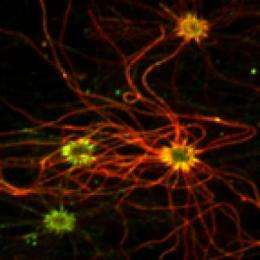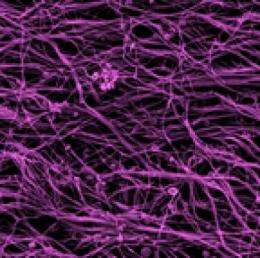Gene therapy restores sense of smell, may aid research into other diseases caused by cilia defects

Scientists have restored the sense of smell in mice through gene therapy for the first time—a hopeful sign for people who can't smell anything from birth or lose it due to disease.
The achievement in curing congenital anosmia—the medical term for lifelong inability to detect odors—may also aid research on other conditions that also stem from problems with the cilia. Those tiny hair-shaped structures on the surfaces of cells throughout the body are involved in many diseases, from the kidneys to the eyes.
The new findings, published online in Nature Medicine, come from a team at the University of Michigan Medical School and their colleagues at several other institutions.
The researchers caution that it will take time for their work to affect human treatment, and that it will be most important for people who have lost their sense of smell due to a genetic disorder, rather than those who lose it due to aging, head trauma, or chronic sinus problems. But their work paves the way for a better understanding of anosmia at the cellular level.
"Using gene therapy in a mouse model of cilia dysfunction, we were able to rescue and restore olfactory function, or sense of smell," says senior author Jeffrey Martens, Ph.D., an associate professor of pharmacology at U-M. "Essentially, we induced the neurons that transmit the sense of smell to regrow the cilia they'd lost."
The mice in the study all had a severe genetic defect that affected a protein called IFT88, causing a lack of cilia throughout their bodies. Such mice are prone to poor feeding and to early death as a result. In humans, the same genetic defect is fatal.

The researchers were able to insert normal IFT88 genes into the cells of the mice by giving them a common cold virus loaded with the normal DNA sequence, and allowing the virus to infect them and insert the DNA into the mouse's own cells. They then monitored cilia growth, feeding habits, and well as signals within and between the nerve cells, called neurons, that are involved in the sense of smell.
Only 14 days after the three-day treatment, the mice had a 60 percent increase in their body weight, an indication they were likely eating more. Cell-level indicators showed that neurons involved in smelling were firing correctly when the mice were exposed to amyl acetate, a strong-smelling chemical also called banana oil.
"At the molecular level, function that had been absent was restored," says Martens.
"By restoring the protein back into the olfactory neurons, we could give the cell the ability to regrow and extend cilia off the dendrite knob, which is what the olfactory neuron needs to detect odorants," says postdoctoral fellow and first author Jeremy McIntyre, Ph.D.
Martens notes that the research has importance for other ciliopathies, or diseases caused by cilia dysfunction. These include such conditions as polycystic kidney disease, retinitis pigmentosa in the eye, and rare inherited disorders such as Alström syndrome, Bardet-Biedl syndrome, primary ciliary dyskinesia and nephronopthisis.
Scientists believe that nearly every cell in the body has the capacity to grow one or more cilia. In the olfactory system, multiple cilia project from olfactory sensory neurons, sensory cells that are found in the olfactory epithelium, tissue high up in the nasal cavity. Receptors that bind odorants are localized on the cilia, which is why a loss of cilia results in a loss in the ability to smell.
Because the new findings show that gene therapy is a viable option for the functional rescue of cilia in established, already differentiated cells, researchers working on those conditions might be able to use gene therapy to attempt to restore cilia function as well.
Meanwhile, Martens and his team will continue to look for other cilia-related genetic causes of anosmia, including those that are not lethal in humans.
"We hope this stimulates the olfactory research community to look at anosmia caused by other factors, such as head trauma and degenerative diseases," he says. "We know a lot about how this system works – now have to look at how to fix it when it malfunctions." And, he notes because the neurons involved in the sense of smell connect to the nose, delivery of gene therapy treatments would not need to involve invasive procedures.
More information: Nature Medicine, Advance Online Publication, DOI 10.1038/nm.2860















